Marketing Fundamentals Report: Consumer Behavior and Myer
VerifiedAdded on 2020/03/04
|12
|2103
|198
Report
AI Summary
This report analyzes the marketing fundamentals of Myer, a prominent retail store in Australia. It begins by exploring consumer behavior, discussing the influences of reference groups, loyalty programs, income, age, and virtual communities. The report then outlines the buyer decision process, detailing the five stages: need recognition, information search, evaluation of alternatives, purchase decision, and post-purchase behavior. Market segmentation is examined, including demographic, geographic, psychographic, and behavioral variables, with a focus on Myer's strategies. The report also covers target market selection and the importance of positioning. Finally, it provides recommendations for Myer, such as targeting the middle-income group and the metrosexual men segment, and suggests strategies to attract these customer segments. The report uses figures to illustrate the customer buying process, market segmentation, target market and perpetual map, and references relevant literature to support its analysis.
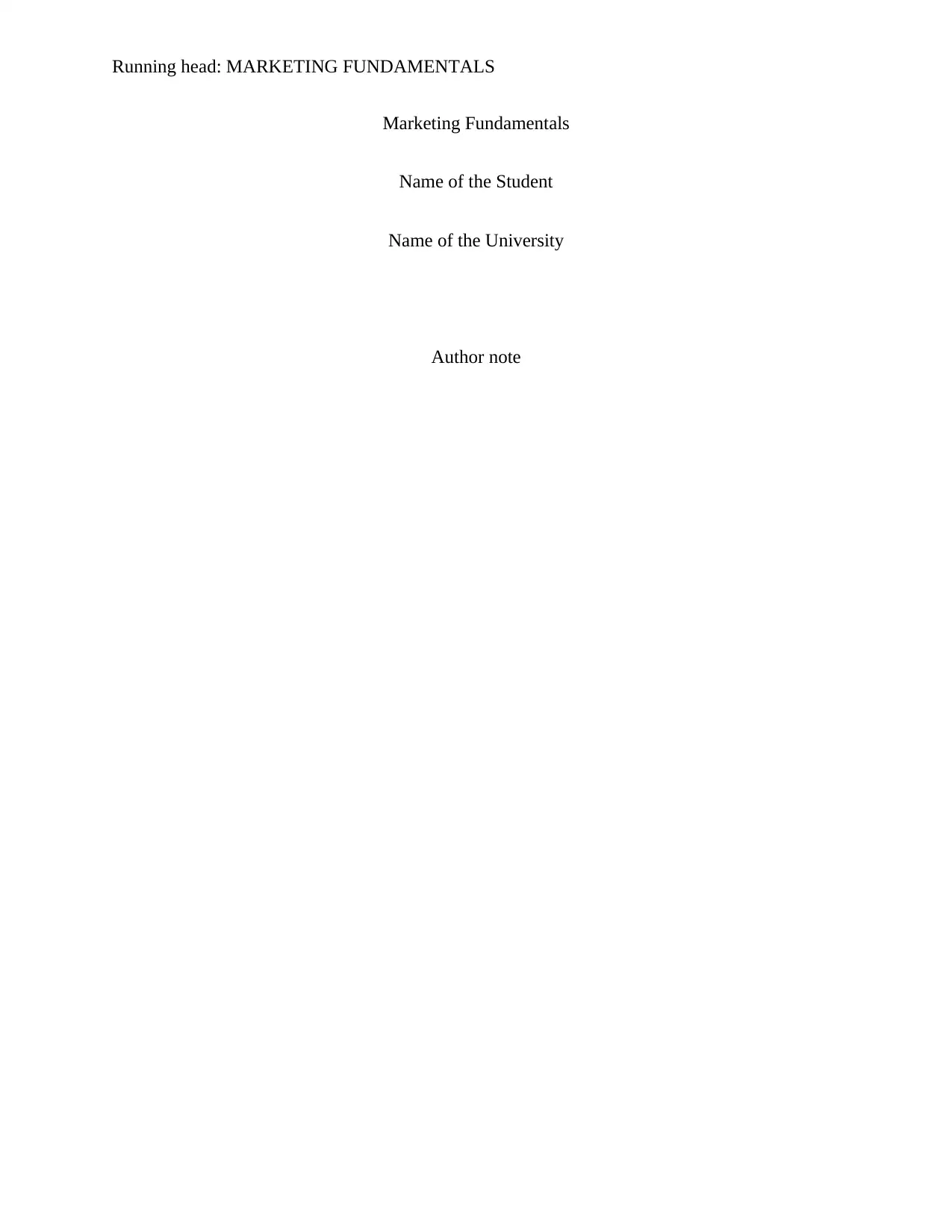
Running head: MARKETING FUNDAMENTALS
Marketing Fundamentals
Name of the Student
Name of the University
Author note
Marketing Fundamentals
Name of the Student
Name of the University
Author note
Paraphrase This Document
Need a fresh take? Get an instant paraphrase of this document with our AI Paraphraser
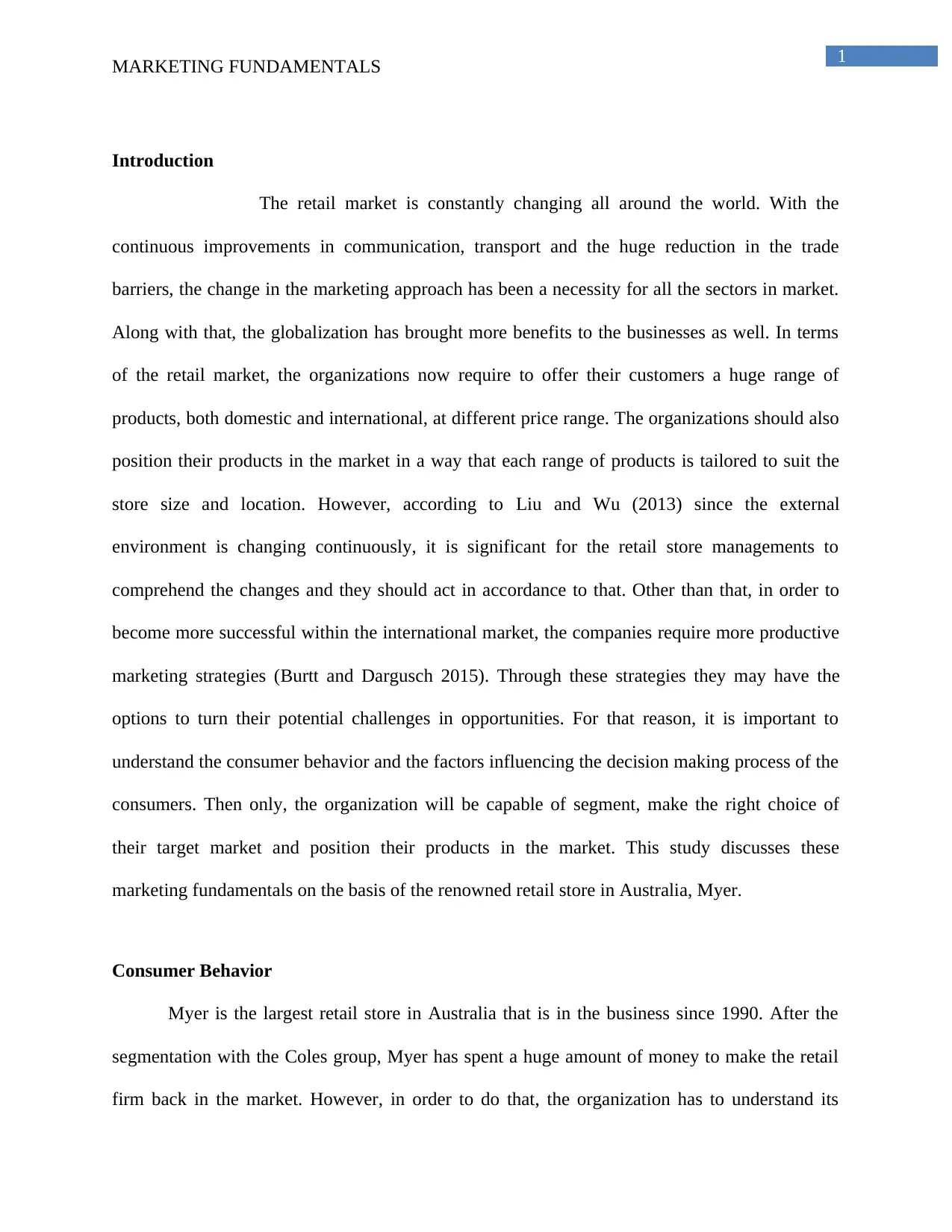
1
MARKETING FUNDAMENTALS
Introduction
The retail market is constantly changing all around the world. With the
continuous improvements in communication, transport and the huge reduction in the trade
barriers, the change in the marketing approach has been a necessity for all the sectors in market.
Along with that, the globalization has brought more benefits to the businesses as well. In terms
of the retail market, the organizations now require to offer their customers a huge range of
products, both domestic and international, at different price range. The organizations should also
position their products in the market in a way that each range of products is tailored to suit the
store size and location. However, according to Liu and Wu (2013) since the external
environment is changing continuously, it is significant for the retail store managements to
comprehend the changes and they should act in accordance to that. Other than that, in order to
become more successful within the international market, the companies require more productive
marketing strategies (Burtt and Dargusch 2015). Through these strategies they may have the
options to turn their potential challenges in opportunities. For that reason, it is important to
understand the consumer behavior and the factors influencing the decision making process of the
consumers. Then only, the organization will be capable of segment, make the right choice of
their target market and position their products in the market. This study discusses these
marketing fundamentals on the basis of the renowned retail store in Australia, Myer.
Consumer Behavior
Myer is the largest retail store in Australia that is in the business since 1990. After the
segmentation with the Coles group, Myer has spent a huge amount of money to make the retail
firm back in the market. However, in order to do that, the organization has to understand its
MARKETING FUNDAMENTALS
Introduction
The retail market is constantly changing all around the world. With the
continuous improvements in communication, transport and the huge reduction in the trade
barriers, the change in the marketing approach has been a necessity for all the sectors in market.
Along with that, the globalization has brought more benefits to the businesses as well. In terms
of the retail market, the organizations now require to offer their customers a huge range of
products, both domestic and international, at different price range. The organizations should also
position their products in the market in a way that each range of products is tailored to suit the
store size and location. However, according to Liu and Wu (2013) since the external
environment is changing continuously, it is significant for the retail store managements to
comprehend the changes and they should act in accordance to that. Other than that, in order to
become more successful within the international market, the companies require more productive
marketing strategies (Burtt and Dargusch 2015). Through these strategies they may have the
options to turn their potential challenges in opportunities. For that reason, it is important to
understand the consumer behavior and the factors influencing the decision making process of the
consumers. Then only, the organization will be capable of segment, make the right choice of
their target market and position their products in the market. This study discusses these
marketing fundamentals on the basis of the renowned retail store in Australia, Myer.
Consumer Behavior
Myer is the largest retail store in Australia that is in the business since 1990. After the
segmentation with the Coles group, Myer has spent a huge amount of money to make the retail
firm back in the market. However, in order to do that, the organization has to understand its

2
MARKETING FUNDAMENTALS
consumer behavior (Myer. 2017). According to Bruwer and Li (2017), the term consumer
behavior involves 'activities people undertake when obtaining, consuming, and disposing of
products and services'. There are different kinds of inputs while determining the behavior of the
consumers, such as the reference groups, tribes, virtual communities etc. As stated by Webb
(2014), the individuals are moving fast towards being the collectivist culture. There is certainly
no doubt that the behaviors of the customers get heavily influenced by their groups. Most of the
individuals tend to strive for conforming to their specific group behavior in order to please
others; therefore this tendency influences the choice of buying to a great extent. Myer has around
three million customers. They have different kinds of loyalty programs for their customers.
These programs also act as a major external influence on the consumer behavior. A recent survey
indicates that income and age of the customers are two major factors that influence the consumer
behavior in the retail sector in Australia (Schnittger and Fisher 2017). The higher income groups
the customers belong to, the higher price they want to pay for their food and domestic choices.
Other than these internal factors, the external factors that influence the consumer behavior are
the group behaviors. In the era of virtual communities, people tend to meet others geographically
and thus they share their common points of interests. These communities and their behaviors
tend to influence the consumer behaviors as well. Another influence is the tribes, who are mostly
characterized by their consumption behavior. Also, the sub-cultures influence the behavior of the
consumers to buy things according to their group choices as well.
The Buyer Decision Process
The Buyer decision process defines the journey of the consumers before they decide to
buy any product. For any business, especially in retail, it is very much significant to understand
the buying procedure of the consumers, not only for the sales department, but it is also important
MARKETING FUNDAMENTALS
consumer behavior (Myer. 2017). According to Bruwer and Li (2017), the term consumer
behavior involves 'activities people undertake when obtaining, consuming, and disposing of
products and services'. There are different kinds of inputs while determining the behavior of the
consumers, such as the reference groups, tribes, virtual communities etc. As stated by Webb
(2014), the individuals are moving fast towards being the collectivist culture. There is certainly
no doubt that the behaviors of the customers get heavily influenced by their groups. Most of the
individuals tend to strive for conforming to their specific group behavior in order to please
others; therefore this tendency influences the choice of buying to a great extent. Myer has around
three million customers. They have different kinds of loyalty programs for their customers.
These programs also act as a major external influence on the consumer behavior. A recent survey
indicates that income and age of the customers are two major factors that influence the consumer
behavior in the retail sector in Australia (Schnittger and Fisher 2017). The higher income groups
the customers belong to, the higher price they want to pay for their food and domestic choices.
Other than these internal factors, the external factors that influence the consumer behavior are
the group behaviors. In the era of virtual communities, people tend to meet others geographically
and thus they share their common points of interests. These communities and their behaviors
tend to influence the consumer behaviors as well. Another influence is the tribes, who are mostly
characterized by their consumption behavior. Also, the sub-cultures influence the behavior of the
consumers to buy things according to their group choices as well.
The Buyer Decision Process
The Buyer decision process defines the journey of the consumers before they decide to
buy any product. For any business, especially in retail, it is very much significant to understand
the buying procedure of the consumers, not only for the sales department, but it is also important
⊘ This is a preview!⊘
Do you want full access?
Subscribe today to unlock all pages.

Trusted by 1+ million students worldwide

3
MARKETING FUNDAMENTALS
for the manufacturing and marketing department. Understanding the buyer’s decision process
will help the organization to align all the future strategies in accordance to that. The five stage
framework of the buyer decision process tends to evaluate the buying procedure of the
consumers. The five stages introduced by John Dewey are:
Need or Problem recognition
This stage is mostly recognized as the most significant and the first stage of making the
decision process of the customers. A buying procedure cannot take place if there is no
recognition of the requirement of the customers. This requirement may be triggered by either the
external stimuli such as word of mouth or advertising and internal stimuli, such as thirst or
hunger (Myers 2015).
Search of information
After the recognition of the problem, the next stage is where the consumer takes the issue
to the next level for finding out whether there is any solution to the problem. At this stage the
buyer makes effort for searching both the external and internal business environments for
identifying and evaluating the source of information that is related to the main buying decision
(Hunt 2014). The customer may also rely on the visual, print or the online media or word of
mouth by any known person.
Evaluating the alternatives
Customers also evaluate various brands or products before purchasing anything. At this
stage the customers tend to evaluate all the potential buying options based on the product
attributes. The customer crosschecks whether a particular product has the benefits which the
consumer is seeking (Myers 2015). This stage is heavily influenced by the attitude of the
MARKETING FUNDAMENTALS
for the manufacturing and marketing department. Understanding the buyer’s decision process
will help the organization to align all the future strategies in accordance to that. The five stage
framework of the buyer decision process tends to evaluate the buying procedure of the
consumers. The five stages introduced by John Dewey are:
Need or Problem recognition
This stage is mostly recognized as the most significant and the first stage of making the
decision process of the customers. A buying procedure cannot take place if there is no
recognition of the requirement of the customers. This requirement may be triggered by either the
external stimuli such as word of mouth or advertising and internal stimuli, such as thirst or
hunger (Myers 2015).
Search of information
After the recognition of the problem, the next stage is where the consumer takes the issue
to the next level for finding out whether there is any solution to the problem. At this stage the
buyer makes effort for searching both the external and internal business environments for
identifying and evaluating the source of information that is related to the main buying decision
(Hunt 2014). The customer may also rely on the visual, print or the online media or word of
mouth by any known person.
Evaluating the alternatives
Customers also evaluate various brands or products before purchasing anything. At this
stage the customers tend to evaluate all the potential buying options based on the product
attributes. The customer crosschecks whether a particular product has the benefits which the
consumer is seeking (Myers 2015). This stage is heavily influenced by the attitude of the
Paraphrase This Document
Need a fresh take? Get an instant paraphrase of this document with our AI Paraphraser
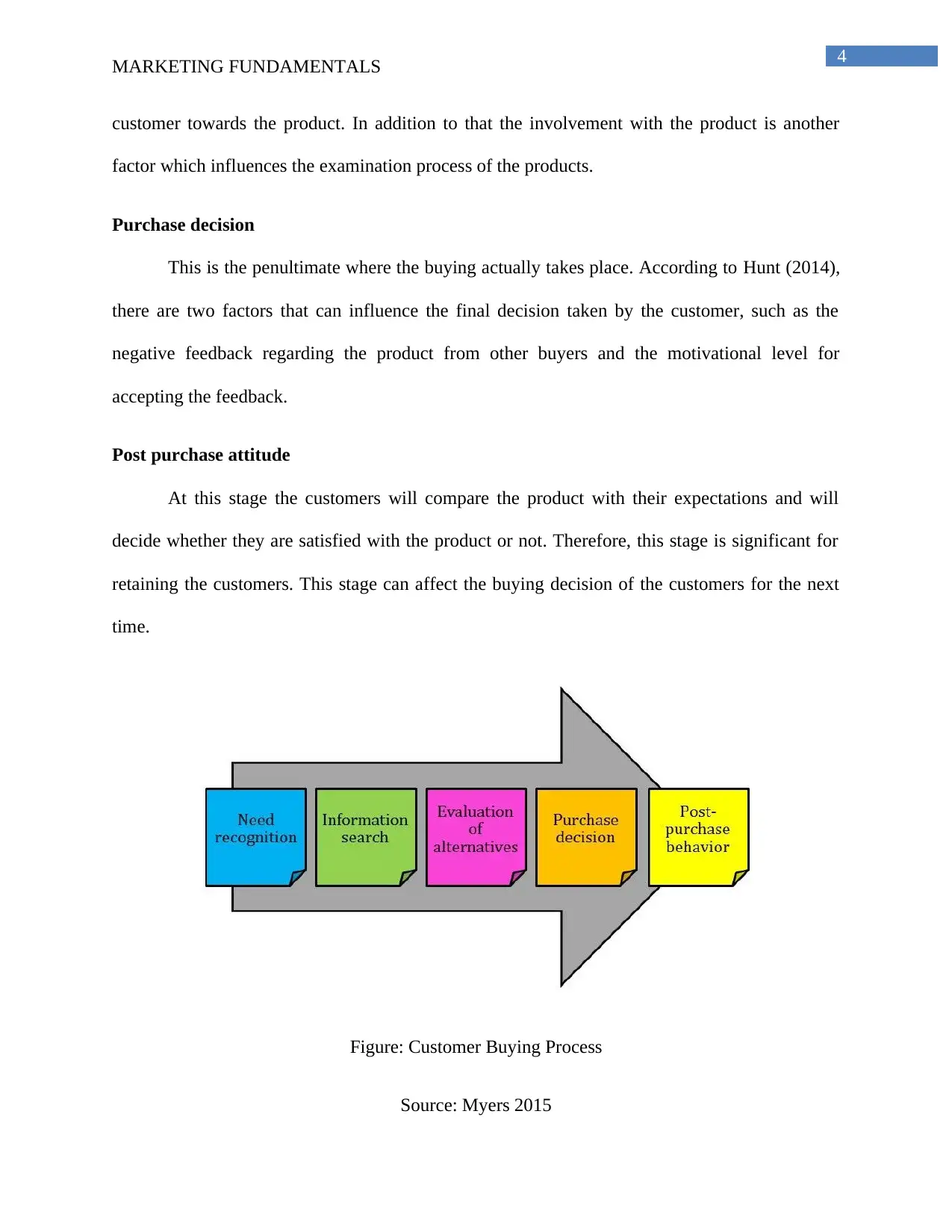
4
MARKETING FUNDAMENTALS
customer towards the product. In addition to that the involvement with the product is another
factor which influences the examination process of the products.
Purchase decision
This is the penultimate where the buying actually takes place. According to Hunt (2014),
there are two factors that can influence the final decision taken by the customer, such as the
negative feedback regarding the product from other buyers and the motivational level for
accepting the feedback.
Post purchase attitude
At this stage the customers will compare the product with their expectations and will
decide whether they are satisfied with the product or not. Therefore, this stage is significant for
retaining the customers. This stage can affect the buying decision of the customers for the next
time.
Figure: Customer Buying Process
Source: Myers 2015
MARKETING FUNDAMENTALS
customer towards the product. In addition to that the involvement with the product is another
factor which influences the examination process of the products.
Purchase decision
This is the penultimate where the buying actually takes place. According to Hunt (2014),
there are two factors that can influence the final decision taken by the customer, such as the
negative feedback regarding the product from other buyers and the motivational level for
accepting the feedback.
Post purchase attitude
At this stage the customers will compare the product with their expectations and will
decide whether they are satisfied with the product or not. Therefore, this stage is significant for
retaining the customers. This stage can affect the buying decision of the customers for the next
time.
Figure: Customer Buying Process
Source: Myers 2015

5
MARKETING FUNDAMENTALS
Segmentation
Segmentation of the market indicates to the division of the market place in different
distinct group of customers on the basis of different features of their requirements and the
customer behavior. According to Meyer (2013) there are four different parameters that segments
the entire market place such the demographic variable, geographic variable, behavioral variable
and psychographic variable. However, it should also be noted that any single variable cannot be
treated for fitting the segmentation within the market place. In most cases two or more segments
come together for segmenting the market. In the retail market in Australia, for Myer, the
demographic segmentation is the most significant one. The life cycle, age, yearly income, gender
and generation make a lot difference within the market place. The younger the buyers are, the
more they will buy fashionable clothes, fast food, beverages etc. Also, the gender segmentation
is very important as some products are only target the women customers such as cosmetics or
styling products (von Meyer-Höfer, Nitzko and Spiller 2015). However, the metro sexuality
should also be taken into account. Therefore Myer can target this sector as well. The geographic
segmentation indicates the division amongst the customers on the basis of their state, nation,
region, neighborhoods and cities. Myer can target more than one area after realizing their
common buying behavior. However, in this era of globalization, the geographical factors are
more related to the demographic segmentation. The psychological segmentation divides the
customers into two different kinds of customers: lifestyle profiles and personality profiles, Myer
mostly targets the higher income group who buy expensive life style products after segmenting
them on the basis of lifestyle and attitudes. The behavioral segment also divides the customers
according to their use, attitude or response to the products.
MARKETING FUNDAMENTALS
Segmentation
Segmentation of the market indicates to the division of the market place in different
distinct group of customers on the basis of different features of their requirements and the
customer behavior. According to Meyer (2013) there are four different parameters that segments
the entire market place such the demographic variable, geographic variable, behavioral variable
and psychographic variable. However, it should also be noted that any single variable cannot be
treated for fitting the segmentation within the market place. In most cases two or more segments
come together for segmenting the market. In the retail market in Australia, for Myer, the
demographic segmentation is the most significant one. The life cycle, age, yearly income, gender
and generation make a lot difference within the market place. The younger the buyers are, the
more they will buy fashionable clothes, fast food, beverages etc. Also, the gender segmentation
is very important as some products are only target the women customers such as cosmetics or
styling products (von Meyer-Höfer, Nitzko and Spiller 2015). However, the metro sexuality
should also be taken into account. Therefore Myer can target this sector as well. The geographic
segmentation indicates the division amongst the customers on the basis of their state, nation,
region, neighborhoods and cities. Myer can target more than one area after realizing their
common buying behavior. However, in this era of globalization, the geographical factors are
more related to the demographic segmentation. The psychological segmentation divides the
customers into two different kinds of customers: lifestyle profiles and personality profiles, Myer
mostly targets the higher income group who buy expensive life style products after segmenting
them on the basis of lifestyle and attitudes. The behavioral segment also divides the customers
according to their use, attitude or response to the products.
⊘ This is a preview!⊘
Do you want full access?
Subscribe today to unlock all pages.

Trusted by 1+ million students worldwide
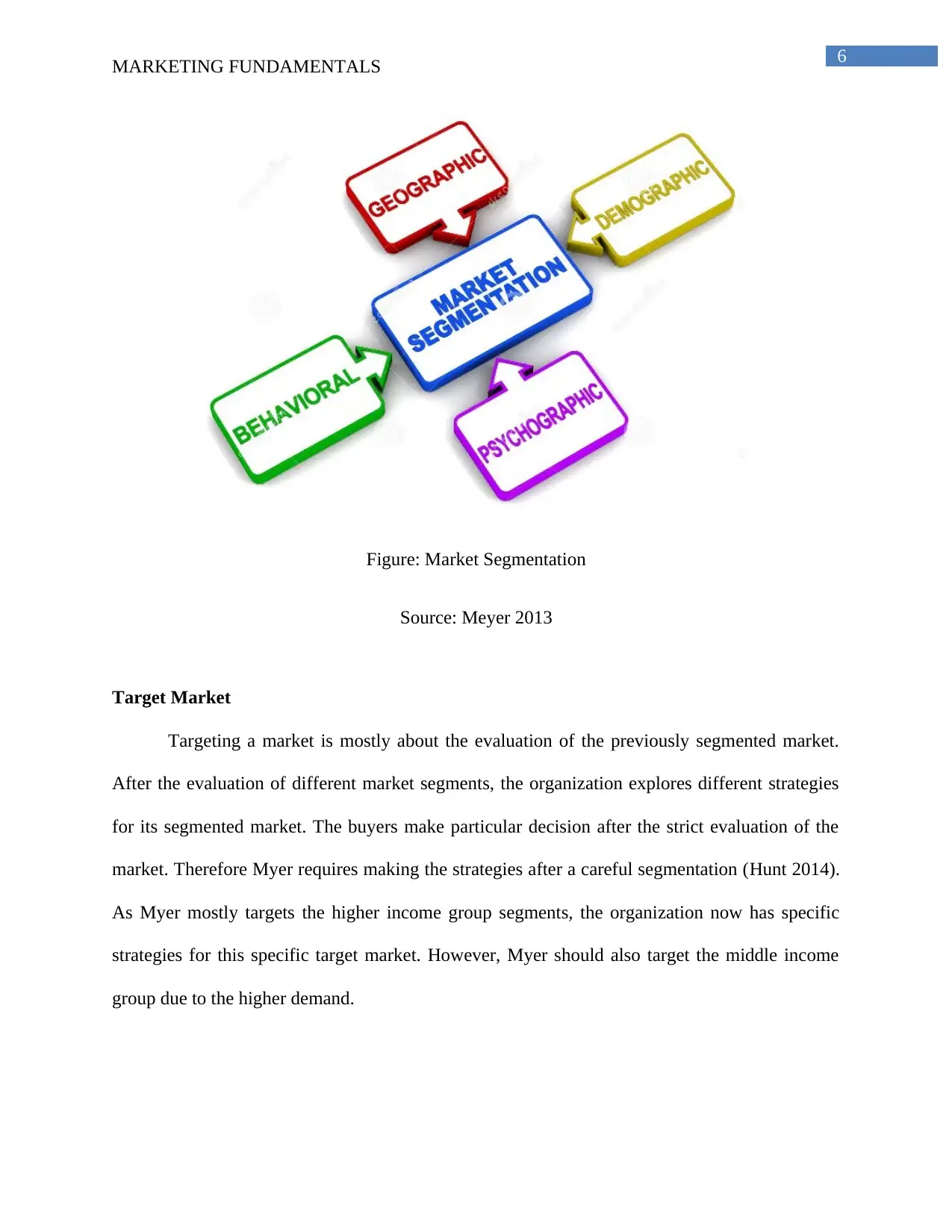
6
MARKETING FUNDAMENTALS
Figure: Market Segmentation
Source: Meyer 2013
Target Market
Targeting a market is mostly about the evaluation of the previously segmented market.
After the evaluation of different market segments, the organization explores different strategies
for its segmented market. The buyers make particular decision after the strict evaluation of the
market. Therefore Myer requires making the strategies after a careful segmentation (Hunt 2014).
As Myer mostly targets the higher income group segments, the organization now has specific
strategies for this specific target market. However, Myer should also target the middle income
group due to the higher demand.
MARKETING FUNDAMENTALS
Figure: Market Segmentation
Source: Meyer 2013
Target Market
Targeting a market is mostly about the evaluation of the previously segmented market.
After the evaluation of different market segments, the organization explores different strategies
for its segmented market. The buyers make particular decision after the strict evaluation of the
market. Therefore Myer requires making the strategies after a careful segmentation (Hunt 2014).
As Myer mostly targets the higher income group segments, the organization now has specific
strategies for this specific target market. However, Myer should also target the middle income
group due to the higher demand.
Paraphrase This Document
Need a fresh take? Get an instant paraphrase of this document with our AI Paraphraser

7
MARKETING FUNDAMENTALS
Figure: Target Market
Source: Hunt 2014
Positioning Map
After the organization is done with segmenting the market place and fixing the target
market, it should position the organization in a place which will help the organization for
operating within the targeted market.
MARKETING FUNDAMENTALS
Figure: Target Market
Source: Hunt 2014
Positioning Map
After the organization is done with segmenting the market place and fixing the target
market, it should position the organization in a place which will help the organization for
operating within the targeted market.
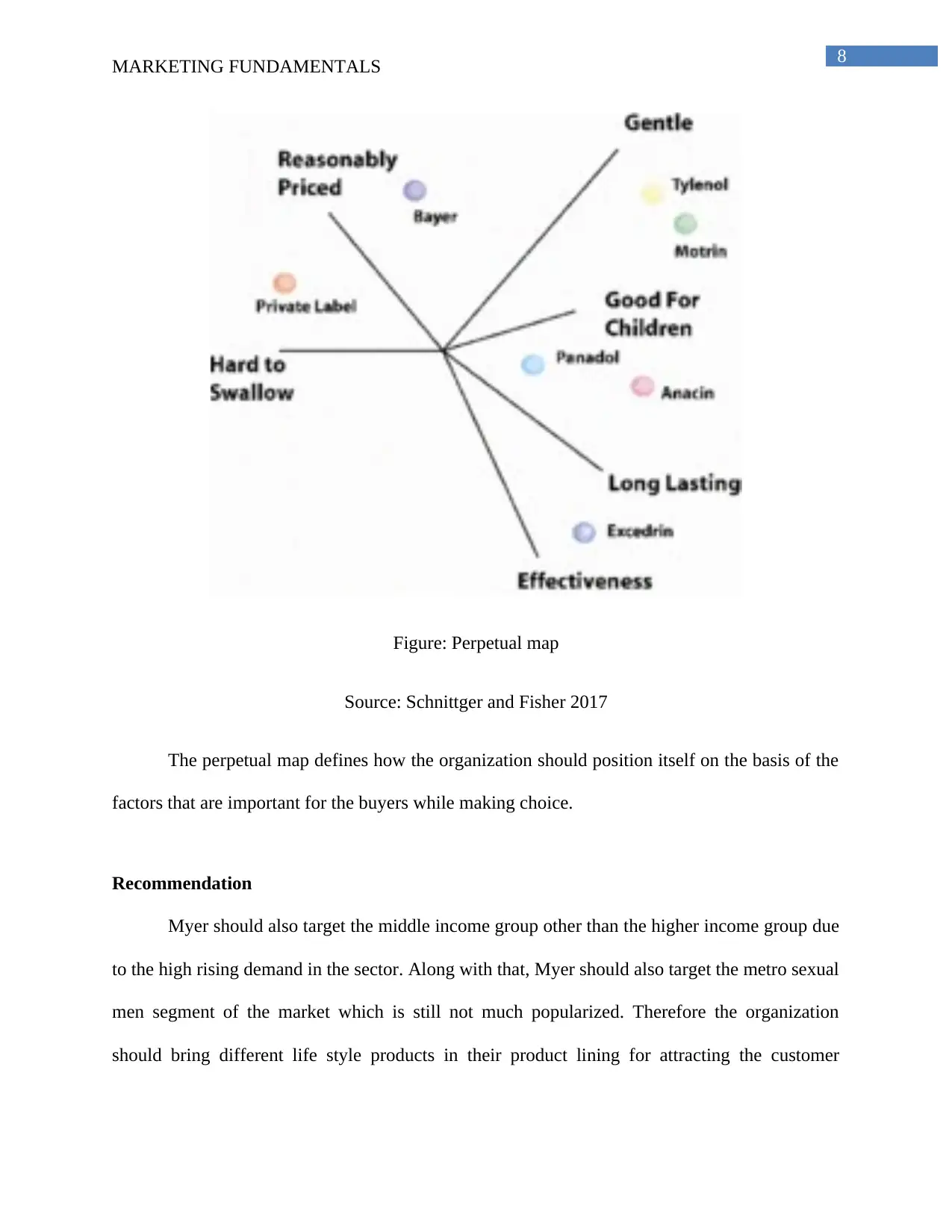
8
MARKETING FUNDAMENTALS
Figure: Perpetual map
Source: Schnittger and Fisher 2017
The perpetual map defines how the organization should position itself on the basis of the
factors that are important for the buyers while making choice.
Recommendation
Myer should also target the middle income group other than the higher income group due
to the high rising demand in the sector. Along with that, Myer should also target the metro sexual
men segment of the market which is still not much popularized. Therefore the organization
should bring different life style products in their product lining for attracting the customer
MARKETING FUNDAMENTALS
Figure: Perpetual map
Source: Schnittger and Fisher 2017
The perpetual map defines how the organization should position itself on the basis of the
factors that are important for the buyers while making choice.
Recommendation
Myer should also target the middle income group other than the higher income group due
to the high rising demand in the sector. Along with that, Myer should also target the metro sexual
men segment of the market which is still not much popularized. Therefore the organization
should bring different life style products in their product lining for attracting the customer
⊘ This is a preview!⊘
Do you want full access?
Subscribe today to unlock all pages.

Trusted by 1+ million students worldwide
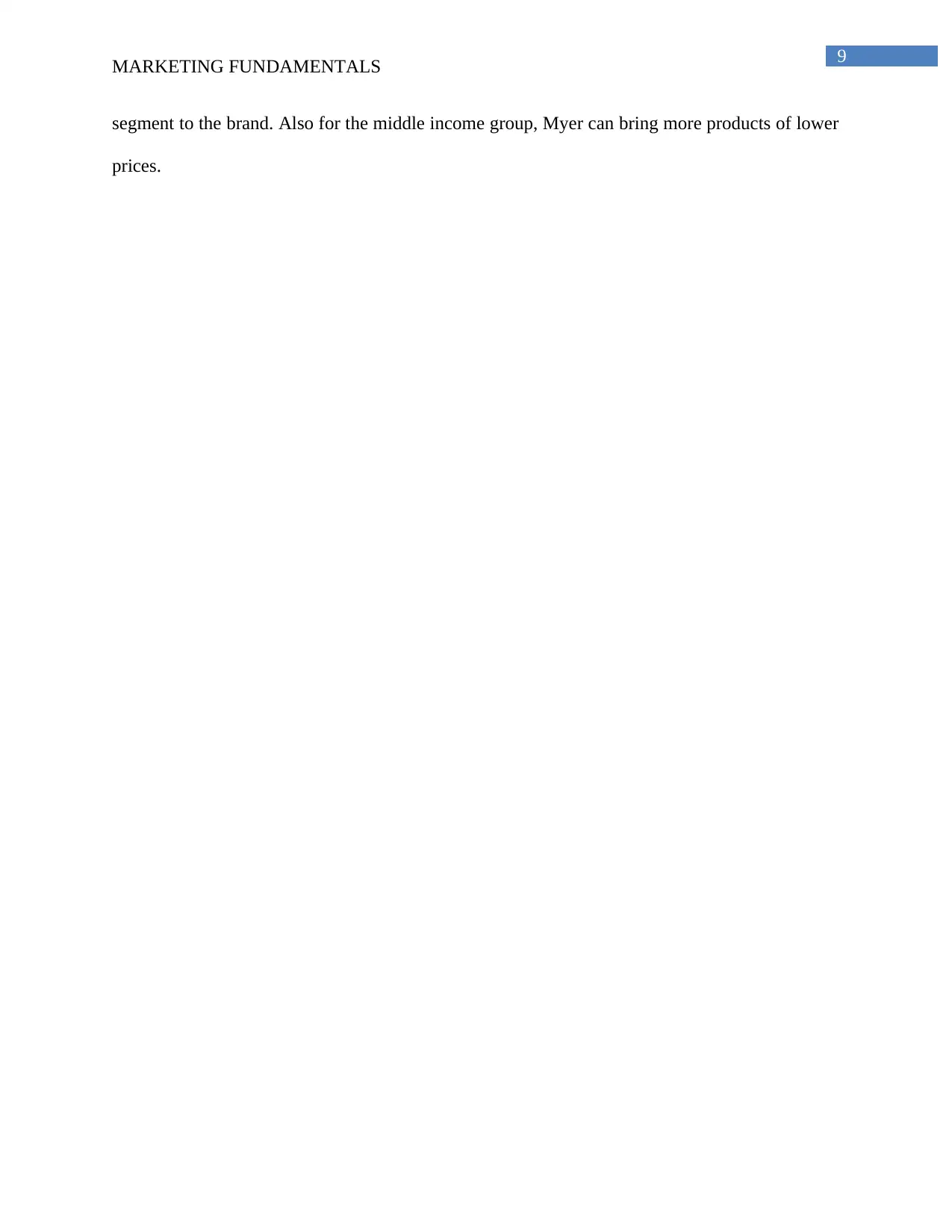
9
MARKETING FUNDAMENTALS
segment to the brand. Also for the middle income group, Myer can bring more products of lower
prices.
MARKETING FUNDAMENTALS
segment to the brand. Also for the middle income group, Myer can bring more products of lower
prices.
Paraphrase This Document
Need a fresh take? Get an instant paraphrase of this document with our AI Paraphraser
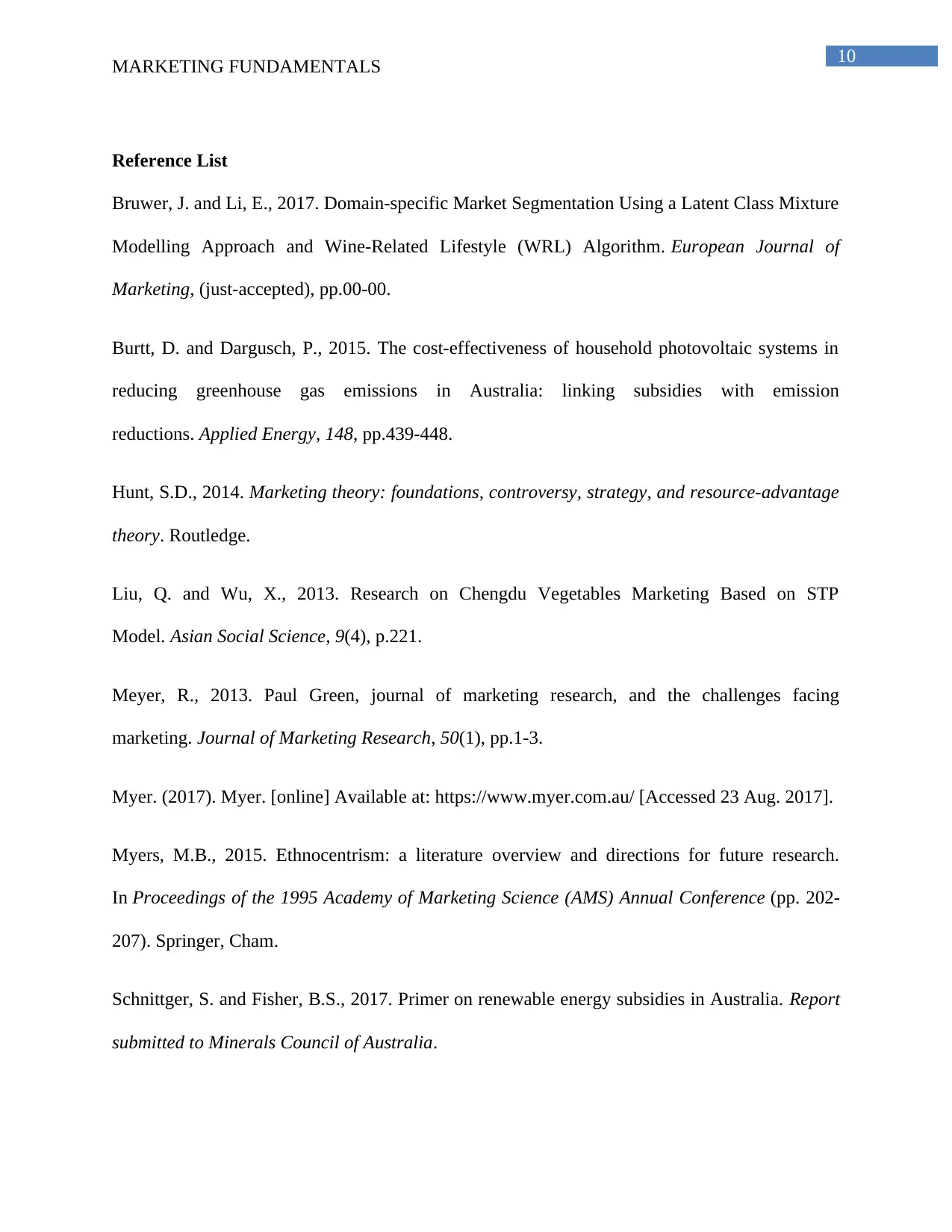
10
MARKETING FUNDAMENTALS
Reference List
Bruwer, J. and Li, E., 2017. Domain-specific Market Segmentation Using a Latent Class Mixture
Modelling Approach and Wine-Related Lifestyle (WRL) Algorithm. European Journal of
Marketing, (just-accepted), pp.00-00.
Burtt, D. and Dargusch, P., 2015. The cost-effectiveness of household photovoltaic systems in
reducing greenhouse gas emissions in Australia: linking subsidies with emission
reductions. Applied Energy, 148, pp.439-448.
Hunt, S.D., 2014. Marketing theory: foundations, controversy, strategy, and resource-advantage
theory. Routledge.
Liu, Q. and Wu, X., 2013. Research on Chengdu Vegetables Marketing Based on STP
Model. Asian Social Science, 9(4), p.221.
Meyer, R., 2013. Paul Green, journal of marketing research, and the challenges facing
marketing. Journal of Marketing Research, 50(1), pp.1-3.
Myer. (2017). Myer. [online] Available at: https://www.myer.com.au/ [Accessed 23 Aug. 2017].
Myers, M.B., 2015. Ethnocentrism: a literature overview and directions for future research.
In Proceedings of the 1995 Academy of Marketing Science (AMS) Annual Conference (pp. 202-
207). Springer, Cham.
Schnittger, S. and Fisher, B.S., 2017. Primer on renewable energy subsidies in Australia. Report
submitted to Minerals Council of Australia.
MARKETING FUNDAMENTALS
Reference List
Bruwer, J. and Li, E., 2017. Domain-specific Market Segmentation Using a Latent Class Mixture
Modelling Approach and Wine-Related Lifestyle (WRL) Algorithm. European Journal of
Marketing, (just-accepted), pp.00-00.
Burtt, D. and Dargusch, P., 2015. The cost-effectiveness of household photovoltaic systems in
reducing greenhouse gas emissions in Australia: linking subsidies with emission
reductions. Applied Energy, 148, pp.439-448.
Hunt, S.D., 2014. Marketing theory: foundations, controversy, strategy, and resource-advantage
theory. Routledge.
Liu, Q. and Wu, X., 2013. Research on Chengdu Vegetables Marketing Based on STP
Model. Asian Social Science, 9(4), p.221.
Meyer, R., 2013. Paul Green, journal of marketing research, and the challenges facing
marketing. Journal of Marketing Research, 50(1), pp.1-3.
Myer. (2017). Myer. [online] Available at: https://www.myer.com.au/ [Accessed 23 Aug. 2017].
Myers, M.B., 2015. Ethnocentrism: a literature overview and directions for future research.
In Proceedings of the 1995 Academy of Marketing Science (AMS) Annual Conference (pp. 202-
207). Springer, Cham.
Schnittger, S. and Fisher, B.S., 2017. Primer on renewable energy subsidies in Australia. Report
submitted to Minerals Council of Australia.
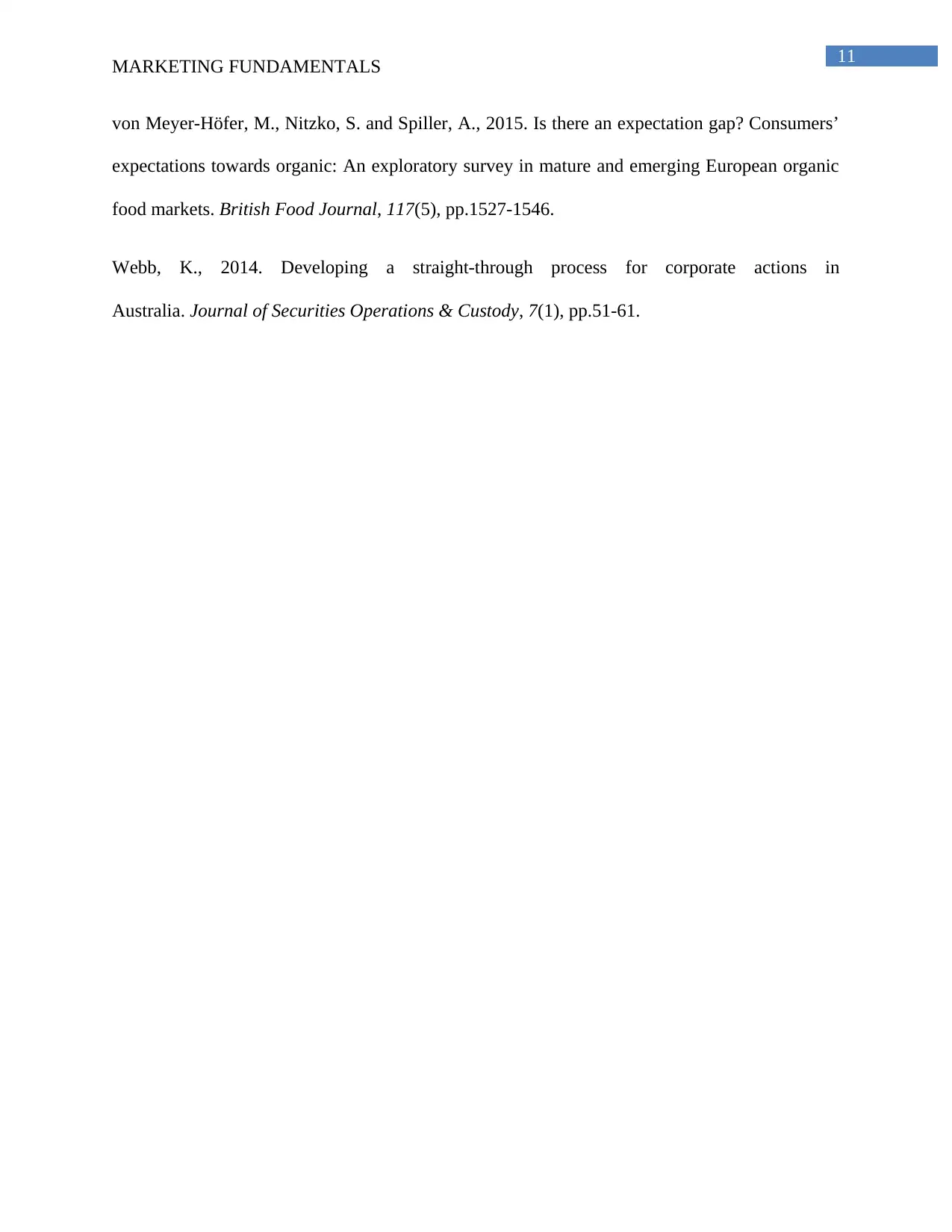
11
MARKETING FUNDAMENTALS
von Meyer-Höfer, M., Nitzko, S. and Spiller, A., 2015. Is there an expectation gap? Consumers’
expectations towards organic: An exploratory survey in mature and emerging European organic
food markets. British Food Journal, 117(5), pp.1527-1546.
Webb, K., 2014. Developing a straight-through process for corporate actions in
Australia. Journal of Securities Operations & Custody, 7(1), pp.51-61.
MARKETING FUNDAMENTALS
von Meyer-Höfer, M., Nitzko, S. and Spiller, A., 2015. Is there an expectation gap? Consumers’
expectations towards organic: An exploratory survey in mature and emerging European organic
food markets. British Food Journal, 117(5), pp.1527-1546.
Webb, K., 2014. Developing a straight-through process for corporate actions in
Australia. Journal of Securities Operations & Custody, 7(1), pp.51-61.
⊘ This is a preview!⊘
Do you want full access?
Subscribe today to unlock all pages.

Trusted by 1+ million students worldwide
1 out of 12
Related Documents
Your All-in-One AI-Powered Toolkit for Academic Success.
+13062052269
info@desklib.com
Available 24*7 on WhatsApp / Email
![[object Object]](/_next/static/media/star-bottom.7253800d.svg)
Unlock your academic potential
Copyright © 2020–2025 A2Z Services. All Rights Reserved. Developed and managed by ZUCOL.





